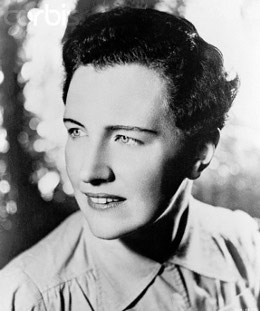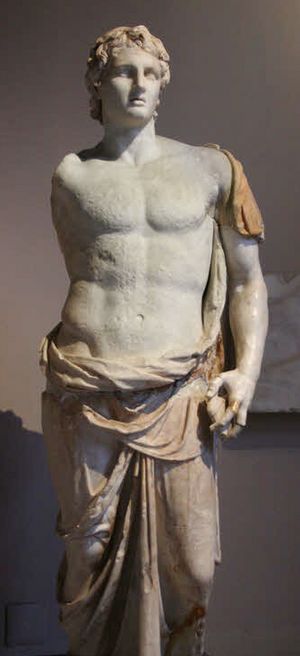Mary Renault facts for kids
Quick facts for kids
Mary Renault
|
|
|---|---|
 |
|
| Born | Eileen Mary Challans 4 September 1905 Forest Gate, Essex, England |
| Died | 13 December 1983 (aged 78) Cape Town, South Africa |
| Occupation | Writer |
| Education | St Hugh's College, Oxford |
| Period | 1939–1981 |
| Genre | Historical fiction, contemporary romance, war novel, gay literature |
| Notable works |
|
| Partner | Julie Mullard (1933–1983) |
Eileen Mary Challans (born September 4, 1905 – died December 13, 1983) was an English writer. She is best known by her pen name, Mary Renault. She wrote many popular historical novels, mostly set in ancient Greece.
Mary Renault was born in Forest Gate, England, in 1905. She studied at St Hugh's College, Oxford, from 1924 to 1928. After college, she worked as a nurse and started writing her first books. These early novels were mostly love stories set in modern times.
In 1948, she moved to Durban, South Africa, with her partner Julie Mullard. Later, they moved to Cape Town, where Mary lived for the rest of her life. Living in South Africa gave her more freedom to write about different kinds of relationships without worrying about strict rules in England. In the 1950s, she began writing historical fiction, which became her most successful work. Today, she is famous for these historical novels.
Renault's books often explore themes of love and different types of relationships. Her work was well-received by critics. She also won many awards during her lifetime and after her death.
Contents
Biography
Early Life and Education
Eileen Mary Challans was born on September 4, 1905, in Forest Gate, Essex, England. She was the oldest daughter of Frank Challans, a doctor, and Mary Clementine Newsome Baxter Challans. Mary had a comfortable childhood, but her parents sometimes argued. She also felt her younger sister, Francis Joyce, was her parents' favorite.
When Mary was 15, her aunt helped her go to a boarding school in Bristol. After that, she went to the University of Oxford. Because she started boarding school later than others, she found it hard to catch up in mathematics and Latin. She used special books called the Loeb Classical Library to help her read Greek and Latin texts with English translations.
Mary first went to Levick Family School and Clifton Girls School in Bristol. In 1924, she started at St Hugh's College, Oxford, which was an all-women's college at the time. At Oxford, she studied history, mythology, philosophy, and ancient literature. She learned Latin in her classes, but she taught herself Ancient Greek. She earned her degree in English in 1928. One of her teachers was J. R. R. Tolkien, who encouraged her to write a novel set in medieval times. However, she later destroyed the story because she felt it wasn't true to the time period.
Nursing and First Books
Mary's mother hoped she would get married. After college, when her father did not support her dream of becoming a writer, she left home. To support herself, she began training as a nurse in 1933 at the Radcliffe Infirmary in Oxford. During her training, she met Julie Mullard, another nurse. They became close friends and partners for life.
Mary worked as a nurse while writing her first novel, Purposes of Love. She used the pen name Mary Renault to keep her writing a secret, in case it was not approved of. She chose this name from an old book called Froissart's Chronicles. She used this name for all her books. The novel was published in 1939. After getting money from her publisher, Mary bought a sports car. Even though she had failed her driving test, she decided to drive the car with Julie, who also did not have a license. In June 1939, they were in a car accident, and Julie was seriously hurt. A few weeks later, the two women went to a small cottage in Cornwall. They lived off the money from Purposes of Love.
Mary had almost finished her second novel when World War II began. By May 1940, both Mary and Julie were called to treat patients at Winford Emergency Hospital in Bristol. There, they helped people who had been evacuated from the Battle of Dunkirk. Mary worked in the brain surgery ward at the Radcliffe Infirmary until 1945.
Her novel The Friendly Young Ladies (1943) is about a close relationship between a writer and a nurse. Many believe this story was inspired by her own relationship with Julie Mullard.
Writing Career and Later Life
In 1948, Mary won a large prize of £37,000 from MGM for her book Return to Night. This allowed her to stop nursing and become a full-time writer. Mary and Julie moved to Durban, South Africa. Many writers and artists who wanted more freedom had moved there from Britain and the United States. This allowed Mary and Julie to live openly as a couple.
Mary continued to write successfully after moving to South Africa in 1948, and she kept writing until her death in 1983. In 1964, she became the president of the South African branch of International PEN. This is a group for writers, and she held this position until 1981. Both women were critical of some unfair parts of their new home. They joined the Black Sash movement in the 1950s, which protested against apartheid. Apartheid was a system of racial separation.
Mary traveled in Africa, Greece, and Crete, but she never went back to England. She admired the novelist Patrick O'Brian, and they wrote letters to each other. Mary became ill in August 1983 and was diagnosed with lung cancer and pneumonia. In her last days, she tried to finish a final novel, but it was not completed before she died in Cape Town on December 13, 1983.
Books by Mary Renault
Mary Challans' first six novels were set in modern times. Her first book was Purposes of Love. She published Return to Night in 1947, followed by The North Face in 1948.
Her last modern romance novel, The Charioteer (1953), showed a change in her writing style. It tells the story of two young soldiers in the 1940s. They try to base their friendship on ideas from ancient Greek philosophy, found in Plato's writings like Phaedrus and Symposium. This book explored ideas that Mary later used in her historical novels.
Between 1956 and 1981, Mary Challans focused on historical fiction. All these books were set in ancient Greece. Her first historical novel was The Last of the Wine. This book was very successful, both financially and with critics. She then wrote several other historical novels. Her historical books include two novels about the Greek hero Theseus and a series of three books about the life of Alexander the Great.
Themes in Her Work
Relationships
A main idea in Mary Challans' books, both modern and historical, is how love can be like a struggle between someone who pursues and someone who is pursued. This idea was greatly influenced by the philosopher Plato, especially his book Phaedrus, which is about love. Her novels often explore relationships with age differences or differences in social status. In her books about same-sex couples, these differences often replace traditional gender roles.
Role of Women
Women do not play a very big part in Mary Challans' historical fiction. They are often shown as wives and mothers. Sometimes, they act in ways that fit old stereotypes, being both helpless and strong. Critics have noticed that women, especially mothers, are often shown in a negative way in her books. This is often thought to be because of the difficult relationship Mary had with her own mother.
Views
Mary Challans was a follower of Platonism, which is a philosophy based on the ideas of Plato. This influenced her personal beliefs about love and relationships.
Views on Social Movements
Mary Challans appreciated her fans who were part of the gay community. However, she was not comfortable with the "gay pride" movement that started in the 1970s. She did not like to be called a lesbian herself. She believed that people should not define themselves only by their sexual orientation. Later in her life, she expressed some negative views about the gay rights movement.
Mary Challans was involved in the anti-apartheid movement in South Africa. She signed petitions and wrote protests against apartheid, which was a system of racial separation. However, she said she was not as active as some others. She felt that apartheid did not directly affect her life, so she did not feel strongly compelled to write about it in her novels.
See also
 In Spanish: Mary Renault para niños
In Spanish: Mary Renault para niños
- Classical reception studies
- LGBT history
- Philippics


